Key takeaways:
- Tempering chocolate is essential for achieving a glossy finish and satisfying snap, enhancing both appearance and flavor.
- Techniques such as the seeding method, tabling method, and microwave method are effective for chocolate tempering, each with its own advantages.
- Precise temperature control and using the right tools, like a thermometer and a heatproof bowl, are crucial for successful tempering.
- Patience and a controlled environment help to avoid common issues like chocolate seizing or having a dull finish.
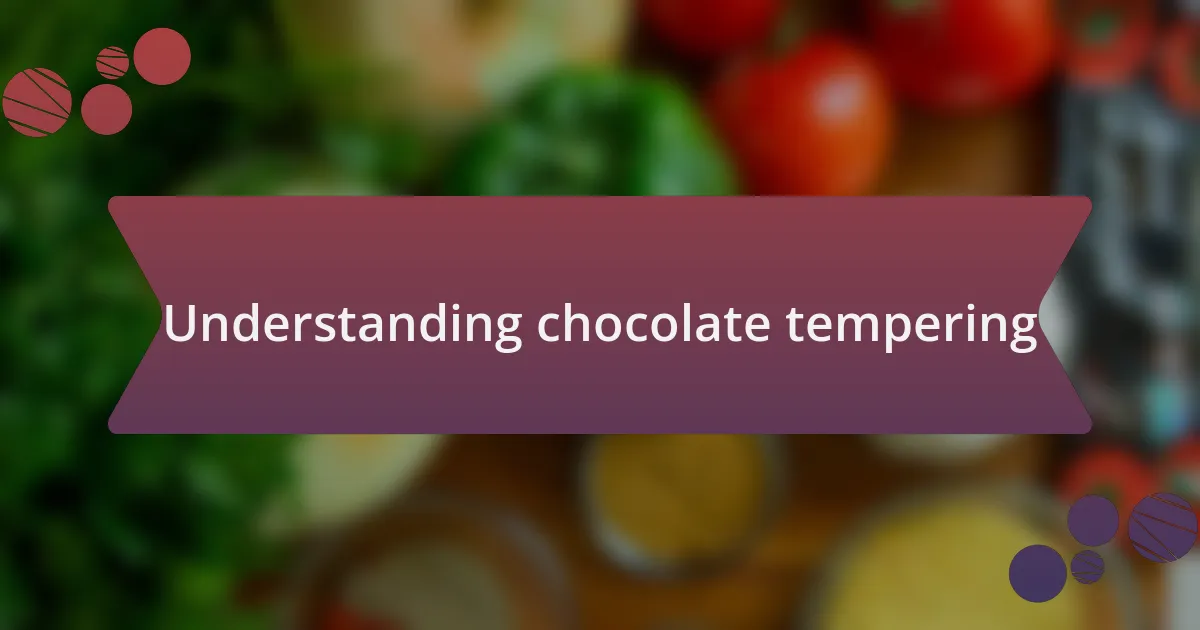
Understanding chocolate tempering
Tempering chocolate is a foundational skill in the world of chocolate making that countless home cooks and professionals alike embrace. It’s all about stabilizing the cocoa butter crystals within the chocolate to give it that beautiful sheen and satisfying snap. Have you ever noticed how perfectly tempered chocolate won’t melt in your hands? That’s the result of proper tempering techniques.
During my early attempts at tempering, I was intimidated by the process—but there’s something almost meditative about it once you get the hang of it. The gentle heat and the rhythmic stirring put me in a flow state. I remember the first time my chocolate came out perfectly tempered; it felt like magic, as if I had unlocked a secret that seasoned chocolatiers guard closely.
Understanding the science behind tempering gives you a profound appreciation for the craft. It’s fascinating how temperature affects the texture and flavor of chocolate; it’s like a dance between heat and cooling. When you control that temperature with precision, you create an experience that elevates your treats from ordinary to extraordinary. Can you think of a chocolate treat that has left a lasting impression on you? Those chocolate confections, whether they’re truffles or bars, often owe their texture and shine to this very technique.
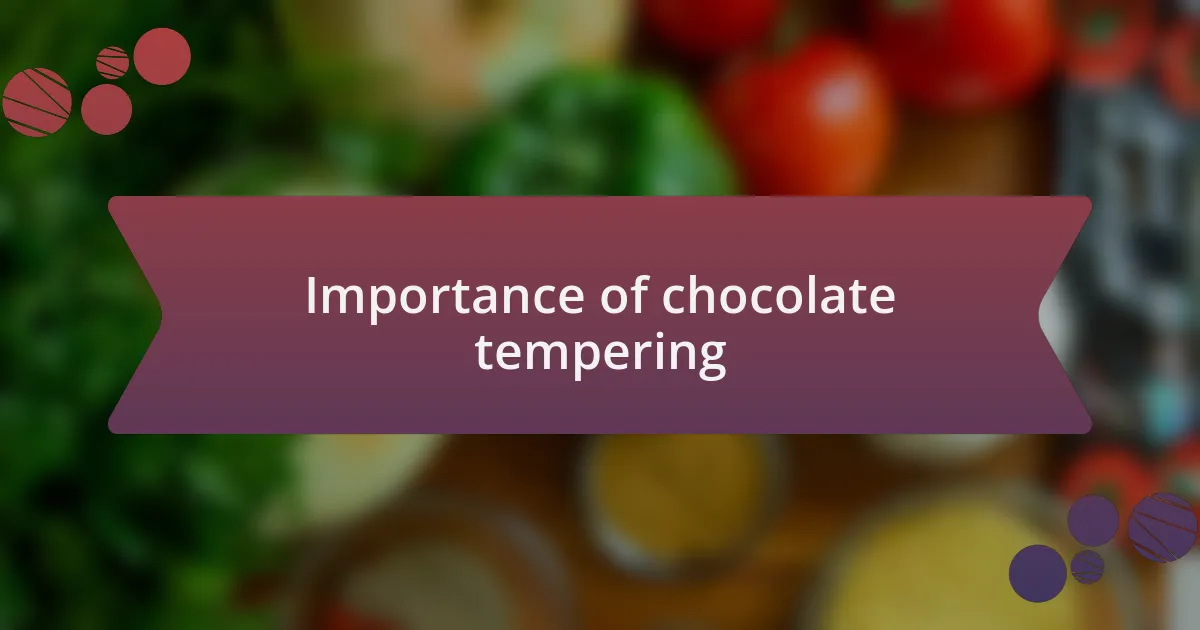
Importance of chocolate tempering
The importance of chocolate tempering cannot be overstated. When I first realized that properly tempered chocolate not only looks tempting but also has a satisfying snap, it felt like discovering a whole new dimension of baking. You might be surprised to learn that this process prevents the dreaded “bloom” that can ruin the appearance and texture of chocolate, giving it a dull look. Have you ever unwrapped a bar only to find a powdery white film on the surface? That’s what happens when chocolate isn’t tempered correctly.
In my experience, the difference between a perfectly tempered chocolate and one that isn’t is night and day. One day, I tried using untempered chocolate in a ganache, and while it tasted good, it lacked the elegance and finish that melts in your mouth. It made me appreciate how tempering not only enhances the chocolate’s visual appeal but also its flavor profile. Isn’t it interesting how a simple technique can elevate something as beloved as chocolate to a new level?
Moreover, tempered chocolate’s stability is crucial for both presentation and shelf life. I remember preparing a batch of chocolate-covered strawberries for a gathering. I tempered the chocolate first, and when I saw the glossy finish on the strawberries, I knew it was worth the effort. It’s almost like giving a gift to yourself and your loved ones—one that’s beautiful to look at and delightful to eat. Isn’t that the kind of chocolate experience we all crave?
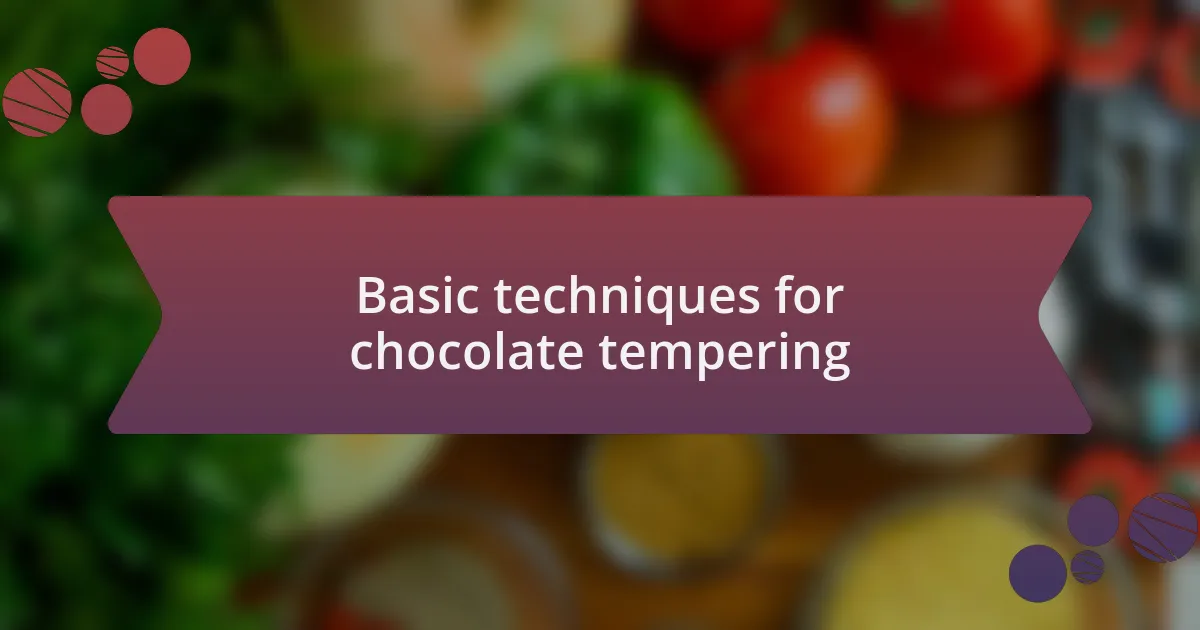
Basic techniques for chocolate tempering
When it comes to tempering chocolate, I often rely on the seeding method, which I find both straightforward and effective. Essentially, you melt chocolate to a specific temperature, then add small pieces of unmelted chocolate to bring it down to the desired working temperature. The first time I tried this, I was amazed at how the melted chocolate transformed right before my eyes, becoming smooth and shiny. Have you ever seen chocolate go from dull to gleaming? It’s quite the rewarding experience.
Another technique I enjoy is the tabling method, where I pour melted chocolate onto a marble surface and work it with a spatula. This is more hands-on, and I find it pleasing to physically engage with the chocolate, feeling its texture change under my hands. I remember the first time I did this; it was like a dance with chocolate, and I couldn’t help but feel exhilarated as I watched it go from liquid to a beautifully tempered form. Isn’t there something poetic about the craft of chocolate-making?
Lastly, I can’t forget about the microwave method—perfect for those quick moments when time is of the essence. Melting chocolate in short bursts while stirring frequently allows for careful temperature control. One evening, I was in a hurry to whip up some chocolate-dipped pretzels, and this method saved the day. With tempered chocolate on hand, the result was not only visually appealing but also incredibly satisfying to munch on. Have you noticed how the right technique can make a huge difference in flavor and texture?
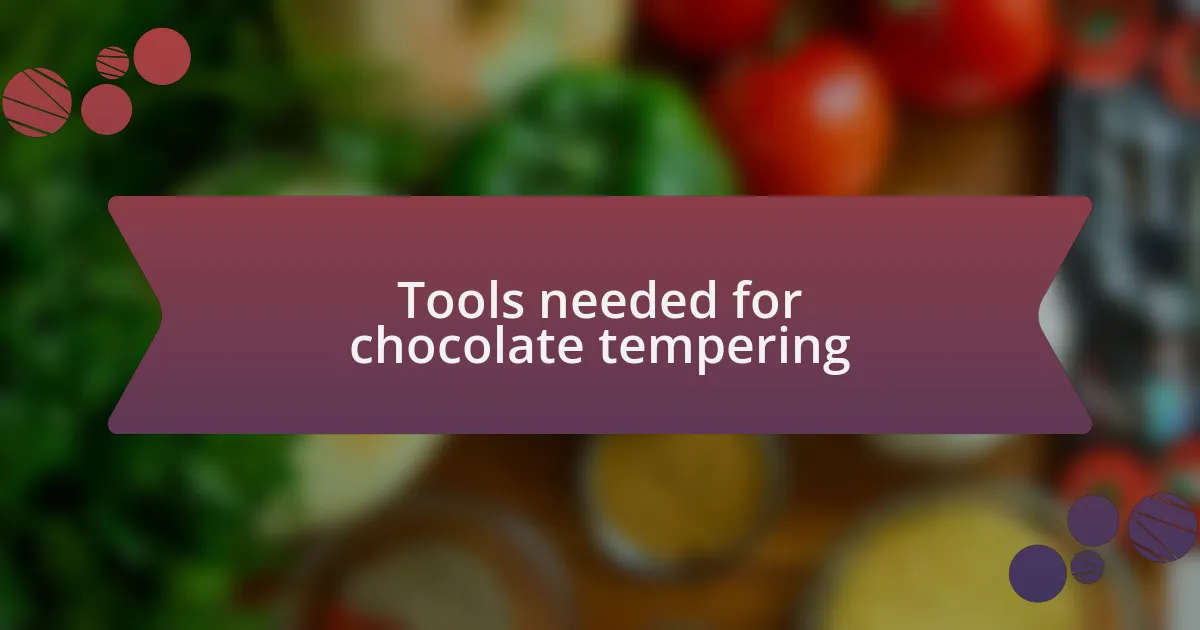
Tools needed for chocolate tempering
When it comes to chocolate tempering, having the right tools is crucial. A good quality thermometer is my go-to since it allows me to monitor the temperature precisely. I still remember the first time I tried to eyeball the temperature; I ended up with a chunky mess instead of the sleek chocolate I was after. Can you imagine the frustration?
A sturdy spatula is also indispensable. It helps in stirring the chocolate smoothly and gives me control during the tempering process. I clearly recall making a batch of chocolate truffles for a friend’s birthday, and using the spatula was almost meditative. The way it glided through the melted chocolate made me feel like an artist crafting a masterpiece.
Lastly, I can’t stress the importance of using a heatproof bowl. Whether it’s glass or stainless steel, it keeps the chocolate at the right temperature without risking burns. In my early attempts, I made the mistake of using plastic, and let me tell you, it was a disaster! It’s fascinating how the right tools can transform what seems intimidating into a delightful experience, isn’t it?
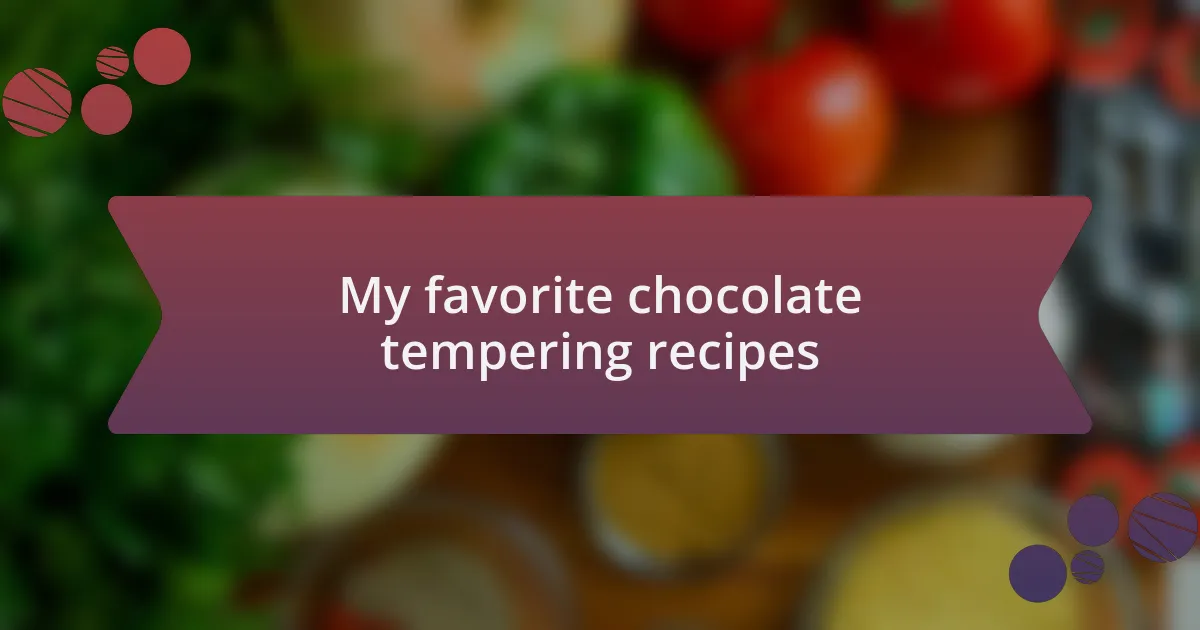
My favorite chocolate tempering recipes
When it comes to my favorite chocolate tempering recipes, one that stands out is the classic “Seeding Method.” I love how simple yet effective it is. After melting my chocolate, I add small pieces of tempered chocolate, which not only helps to lower the temperature but also creates a luscious, glossy finish. I vividly remember the first time I saw that shine; it was a moment of pure joy, akin to finding a hidden treasure in my kitchen.
Another recipe I can’t get enough of is using dark chocolate to create delicate chocolate-covered strawberries. The contrast of the rich chocolate with the fresh, juicy berries is simply irresistible. I still recall the delight of sharing these with friends at a summer gathering—the look on their faces as they bit into the sweet fruit encased in chocolate was priceless. It felt rewarding, like I was sharing a piece of my happiness with them.
Lastly, I have a particular fondness for tempering white chocolate, especially when I incorporate peppermint oil for festive treats. There’s something so satisfying about seeing that smooth, creamy mixture come together. I remember making these for a holiday party; their refreshing flavor paired with the creamy chocolate was a hit. It’s experiences like these that make me cherish the art of chocolate tempering even more.
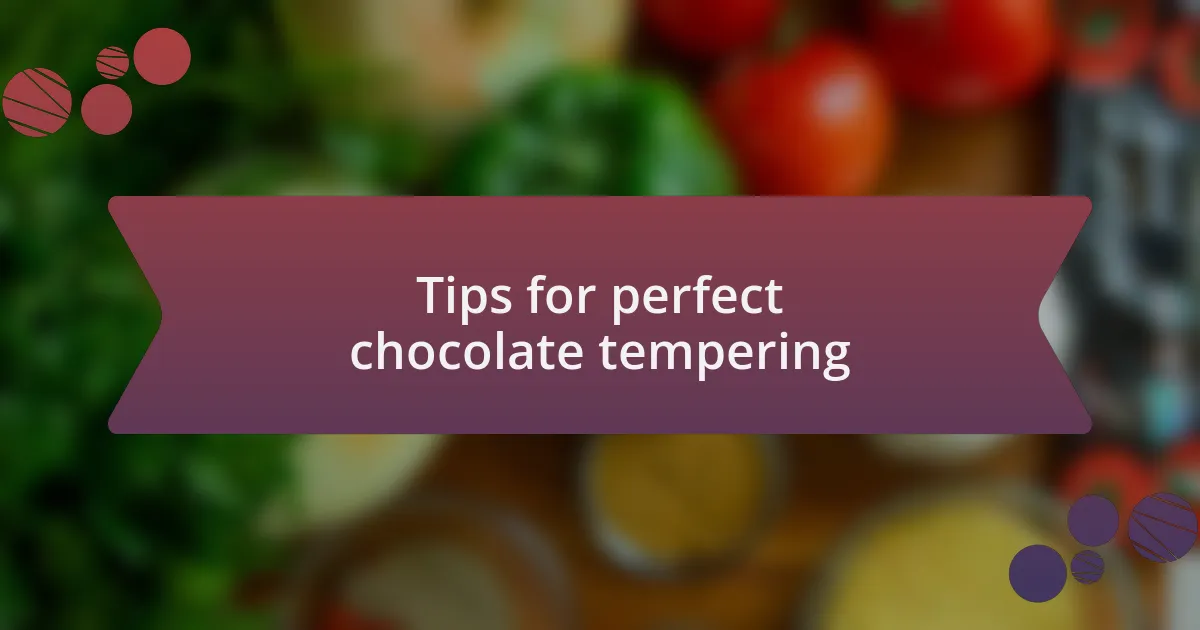
Tips for perfect chocolate tempering
To achieve perfect chocolate tempering, maintaining precise temperatures is crucial. I always double-check my thermometer to ensure my chocolate reaches the right heat for melting—around 115°F for dark chocolate. Has anyone ever had that heart-sinking moment when the chocolate seizes up? Trust me, it’s a learning experience I won’t forget!
Another valuable tip is to work in a cool environment. I’ve noticed that even a warm kitchen can affect my chocolate’s texture and appearance. I remember a particularly warm summer day when I attempted to temper chocolate, and it ended up being a gooey mess. It was frustrating, but I learned to be mindful of my surroundings, ensuring a controlled climate the next time I temper.
Lastly, patience is a secret ingredient in chocolate tempering. Rushing the process has often led me to lumpy chocolate or dull finishes. I learned this the hard way when I couldn’t resist stirring too quickly; the chocolate didn’t set the way I envisioned. Taking my time to carefully mix as the chocolate cools has become part of my routine, and I savor watching that glossy texture develop. What’s your chocolate tempering story?